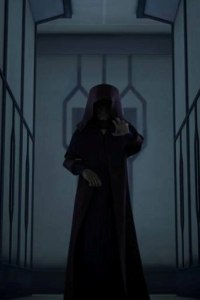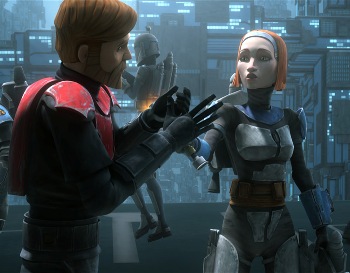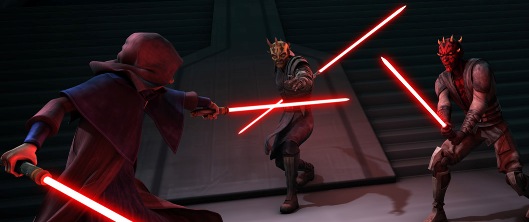 Review by Megan Crouse
Review by Megan Crouse
“The Lawless” was a cool, surprising, and emotionally demanding episode. Simply the events alone were fantastically dramatic. I liked the pacing, which made the episode feel long. It has some beautiful action scenes, including the Maul-Savage-Sidious duel that seems ready to go down in history, as well as a brief but exciting aerial wrestling match between Mandalorians. “The Lawless” also had its flaws, including the role of Duchess Satine. Despite the title, the dark side does have laws, and this episode showed the consequences for those who break them.
A brief, somber opening dedicates the episode to the memory of Ian Abercromie, the voice actor for Palpatine and Sidious, who passed away shortly after recording this episode.
“The Lawless” has a lot in it. Where do I even start? The koan is typically ambiguous: “Morality separates heroes from villains.” Yes, obviously. Sidious, Maul, Satine, and Obi-Wan could get an essay each. And I feel like I’m saying “this is the darkest episode ever” every other episode now. Even the largely comedic ones like “A Sunny Day in the Void” touched some dark subjects, but “The Lawless” was tense and frightening, with some truly nightmarish dark side Force actions.
The episode opened with an “oh hey, it’s that guy!” moment with Korkie the Mandalorian Boy Scout, but the pleasant feeling quickly faded. Is reminding viewers of one of the silliest The Clone Wars episodes (“poisoned tea!”) really a good way to begin what’s supposed to be one of the most serious? But I have to give the show credit for continuity. It’s nice to see older characters again, even if Korkie is precocious and bland. His female former-cadet comrades who joined the rescue have grown up to have strangely Barbie Doll-esque faces. Between them, Bo-Katan, and Satine, though, the first rescue sequence has great gender balance. It also has a little bit of the Uncanny Valley.
Satine and Bo-Katan comprised one of the more surprising twists in the episode. Their conversation involving “the enemy of my enemy is my friend” passes the Bechdel Test, and presumably it’s the armed Bo-Katan, not Korkie, who led the rescue. Initially I liked that the two women knew each other, and presumed that Bo-Katan, with her warrior attitude, had been politically active previously but was also known to Satine as the rare Death Watch member who could also be civil to the opposing party.  I was very surprised that they turned out to be sisters, and feel pretty neutral about it. I suppose it’s true to life that two politically important people might be related, but the nepotism also seems unnecessary. It did give a nice emotional beat to Obi-Wan’s departure from Mandalore, though.
I was very surprised that they turned out to be sisters, and feel pretty neutral about it. I suppose it’s true to life that two politically important people might be related, but the nepotism also seems unnecessary. It did give a nice emotional beat to Obi-Wan’s departure from Mandalore, though.
The other important thing about Bo-Katan is simply how many fights she’s in. At first I didn’t like that the female-heavy rescue mission failed, leaving Satine to be rescued by her white knight – but Bo-Katan rescues that very knight herself later, so what at first appeared to be a failure instead paved the way for a triumphant return. Bo-Katan comes across as both fallible and strong, and I have to salute that. I also like Bo-Katan’s voice a lot now that she’s got more to say. I don’t have previous experience with Katee Sackhoff, but her voice is rich and strong, and I can believe she’s a warrior.
On the other hand, Satine played the Leia figure in “The Lawless.” But not the Leia who ordered Han Solo down a garbage chute and strangled Jabba the Hutt.
The Satine-Obi-Wan relationship could be used to talk more about how Jedi view attachment. The last time we saw them together, they were calling their relationship a friendship. Later she attended Obi-Wan’s fake funeral so he could become Rako Hardeen – but it seems like she found out about the ruse at some point, because she knew he was alive to call him for help. Obi-Wan’s voice goes thick as he responds to her, a nice touch by James Arnold Taylor. There’s also some more continuity when Obi-Wan talked about Ahsoka’s report about the status of Death Watch. I’m glad to see the seasons tie together.
I felt uncomfortably worried, though, when Satine was dragged around by first Obi-Wan, then Maul, and didn’t really contribute. Maul didn’t have the sliminess of Jabba or Miraj Scintel, but he did display Satine and called her a “tool,” an appellation she didn’t challenge.  Satine never gets a moment like Padmé’s “this is how democracy dies” declaration, where she at least preaches her viewpoint strongly. I wanted her to have a last moment of autonomy, or at least self-awareness – her pacifism really failed her, and she doesn’t comment on how that makes her feel. The sadness of her declaring her love for a member of a monastic order also fell a little flat for me. The crowds of Mandalorian civilians have been set aside in this episode to focus on the many important main characters, but Satine is neither a strong character nor a particularly deep one.
Satine never gets a moment like Padmé’s “this is how democracy dies” declaration, where she at least preaches her viewpoint strongly. I wanted her to have a last moment of autonomy, or at least self-awareness – her pacifism really failed her, and she doesn’t comment on how that makes her feel. The sadness of her declaring her love for a member of a monastic order also fell a little flat for me. The crowds of Mandalorian civilians have been set aside in this episode to focus on the many important main characters, but Satine is neither a strong character nor a particularly deep one.
Obi-Wan himself gets a moment with Yoda. I generally like how the Jedi Council is used in The Clone Wars. Yet again Jedi bureaucracy gets in the way of Obi-Wan’s mission: the Council can only act to defend or liberate Republic planets. This has happened enough times now that I’m seeing the theme Dave Filoni discussed at Celebration: part of the point of The Clone Wars is to show how the Republic’s system crippled itself. The Separatists may be the bad guys, but the Republic as the good guys are ineffective. There’s something really disturbing about how the Republic will sit back and let people die because they aren’t allies on paper.
Obi-Wan pulls an Anakin – including borrowing his ship, the Twilight. Obi-Wan is used for some silly humor, but it’s also endearing – he’s a flawed hero. He’s also a cool one, going from the Rako Hardeen armor (more continuity!) to that black and red beskar’gam.
Then there’s the Zabrak brothers. There’s a great contrast between Maul’s crisp, prim discussion of “neutrality” and Savage’s growling at Almec. Maul looks wonderfully menacing as always. He’s very creepy in this episode, slowly moving people around while Force-choking them (or at least Force-toting them by their necks). In the fight with Sidious, he moves like Ray Park.
In my favorite part of the episode, Obi-Wan is menacing too: he tells Maul “I know where you’re from. I know the decision to join the dark side wasn’t yours.” and rewords his fearlessness of dying for his cause from A New Hope. The idea that the dark side wasn’t his choice enrages Maul, which I thought was interesting characterization. Although he was raised first as a slave and then as an apprentice, Maul wants to believe he had choices. The line “I know where you’re from,” really stuck with me – it’s simple, effective, and frightening, making Obi-Wan seem like the smart protagonist he was during his detective work in Attack of the Clones. The line brings Obi-Wan together, solidifies him. It’s actually effective to do what Dave Filoni mentioned in the featurette this episode was supposed to do:  to show Obi-Wan as the ideal Jedi. He can defeat his enemy purely by knowing how his mind works.
to show Obi-Wan as the ideal Jedi. He can defeat his enemy purely by knowing how his mind works.
Not all the dialogue is so great, though. Maul tossed me out of the fictional dream a little when he uses the words “noble flaw” with a straight face. I thought there was a bit of a plot hole when Maul said he wanted to capture Satine in order to make Obi-Wan hurt: did he really plan to be picked up by the Mandalorians specifically all along, so that he could get through Obi-Wan via Satine? It seemed like chance that Pre Viszla found him frozen in a spaceship, and Maul couldn’t have been able to know before then that Satine knew Obi-Wan. Maybe it’s a short-term plan, but that still doesn’t explain how he knew Obi-Wan and Satine were involved.
Obi-Wan and Maul trying to get inside each other’s heads made for a very tense, scary scene. It reminded me of Luke fighting the Emperor in Return of the Jedi, and of course more so when Sidious himself brought out the Force lightning later.
Mas Amedda serves up even more continuity, while Sidious’ white-dot eyes are really creepy. Sidious’ music reminds us that although Obi-Wan looks home free, the show is really not going to get happier from this point. Indeed, by the time Sidious gets to the planet – like in Revenge of the Sith, let’s not concern ourselves with how long it should take for him to travel through space – it’s full-out Mandalorian war outside while Sidious starts his own in the dark interior of the throne room.
The Sidious-Maul confrontation was masterfully tense. Of course it’s helped along by the fact that these are two of the most powerful, most recognizable dark side characters in the franchise. Sidious sounds impressed by Maul, but it’s clear there’s more going on inside the Dark Lord’s head than that.
My reservations about Maul’s motives were summed up in one line: he’s been doing all this to get back to Sidious. I’m glad that’s cleared up. But still, if that was his goal, wouldn’t it have been simpler just to go back to Sidious? Maul knows where Sidious’ hideout in The Works on Coruscant is. Presumably, he knows his comm number. Why didn’t he do that instead of going to a planet distant from the Core and distracting himself with all these Mandalorians?
Sidious sees Maul’s assertion of loyalty as lies anyway, and maybe they are. We’ve seen Maul switch from wanting to murder his Master to being content to serve him before, in the The Wrath of Darth Maul and other EU material. Either way, Maul’s not part of Sidious’ plans any more. In one line their talk becomes an all-out fight, and an awesome one at that.
Maul moves beautifully, with one signature flip in the air before the scene cuts away. In true Return of the Jedi fashion, two plotlines are resolved in big battles at once. I absolutely loved Sidious’ moves. Force-pulling the Zabraks down with him as he fell onto the promenade looked dizzying. The “Guernica”-style frieze in the Mandalorian promenade is a great backdrop now that we get to see it close up.
 The whole fight was epic because of its inevitability. Of course Sidious doesn’t need Maul any more. In a way the Mandalorian arc was a way for the show to keep Maul alive. Sidious was always a guillotine hanging over him, and this fits my suspicion that Sidious never intended Maul to survive The Phantom Menace. I guess Maul really does care about his brother if he’ll abandon his fight against Sidious to go to him. Poor Savage went down while his enemy’s back was turned, adding insult to injury. It’s a sad death, more so because of what might be an about-face at the end: “I’m not like you,” Savage says as his horns shrink and the Nightsisters’ magic leaves him. His eyes also look bigger, and I wonder if he’s temporarily gone back to his friendlier self and his dialogue is an assertion that he never would have agreed with Maul if not for Mother Talzin’s brainwashing. In the commentary, Dave Filoni confirms that Savage “reverts back to his less Frankenstein form.”
The whole fight was epic because of its inevitability. Of course Sidious doesn’t need Maul any more. In a way the Mandalorian arc was a way for the show to keep Maul alive. Sidious was always a guillotine hanging over him, and this fits my suspicion that Sidious never intended Maul to survive The Phantom Menace. I guess Maul really does care about his brother if he’ll abandon his fight against Sidious to go to him. Poor Savage went down while his enemy’s back was turned, adding insult to injury. It’s a sad death, more so because of what might be an about-face at the end: “I’m not like you,” Savage says as his horns shrink and the Nightsisters’ magic leaves him. His eyes also look bigger, and I wonder if he’s temporarily gone back to his friendlier self and his dialogue is an assertion that he never would have agreed with Maul if not for Mother Talzin’s brainwashing. In the commentary, Dave Filoni confirms that Savage “reverts back to his less Frankenstein form.”
Maul will not give up even though Sidious says he’s been “replaced,” and I can’t help but think that means that Maul did want to have an identity outside of Sidious all along. It’s a gorgeous fight between four blades, and I was worried for Maul in precisely the same way I was worried for Luke in Return of the Jedi. The shocking scene was brutal and surprising – instead of going in the direction The Clone Wars often does and adding an element to make a classic Star Wars move more intense, this is almost exactly the same as the Jedi lightning scene, because there’s little room to improve on the emotional impact of a character writhing on the floor.
In the end I was breathless, and wondering how I was going to make a coherent review out of an episode with so many elements. In the other half of the big finale, I was glad to see Bo-Katan survive and assert her culture’s survival. The emotional moment when Obi-Wan notes that she’s Satine’s sister also brought a heartfelt angle to the action-packed scene. The ending of the episode for Maul is a bit of a cliffhanger, and I’m just glad to see him still alive.
The Clone Wars really brought me along for the ride in “The Lawless.” Although part of that can be attributed to my longstanding interest in Maul, this episode also marked a turning point for the Mandalorians, and especially for Obi-Wan. He becomes more strongly devoted to the light just as Maul becomes devoted to the dark.
Megan Crouse writes This Blog Is Full of Words and has also published poetry and short fiction. She is currently working in journalism and paying a lot of attention to pop culture, fandom studies, and Darth Maul.
